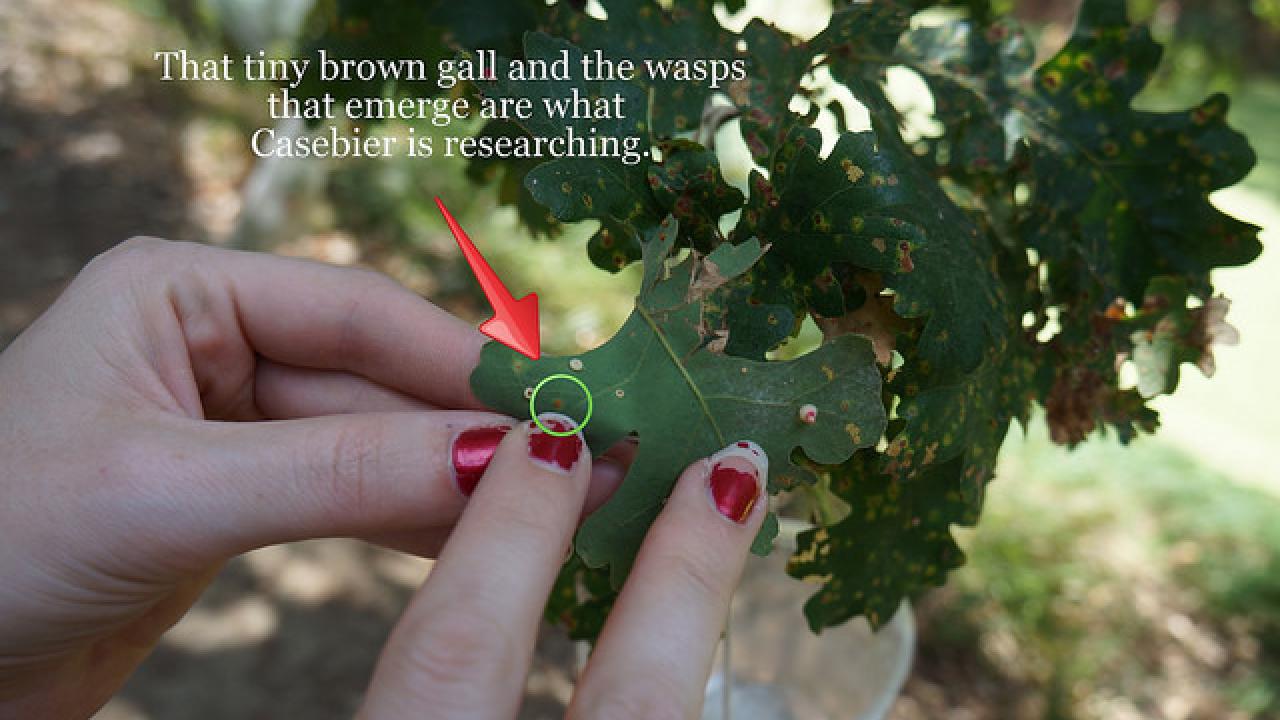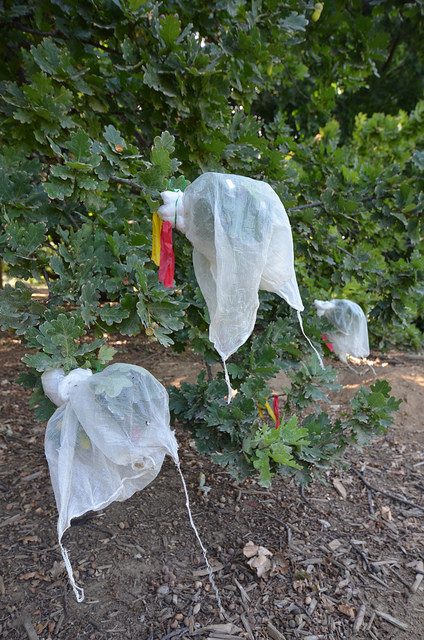
Halloween comes early for Arboretum oaks

If you’ve strolled through the Arboretum lately then you’ve probably noticed intermittent ghost-like gloves covering the tips of oak tree branches. No, those are not DIY tree decorations; they are wasp collection receptacles and all are a part of an independent study project being conducted by undergraduate entomology major Laurie Casebier in collaboration with UC Davis’ Bohart Museum of Entomology
Casebier, who cannot remember a time she wasn’t fascinated with insects, is studying Neuroterus saltatorious, also known as California jumping gall wasp. She travels around the Arboretum courtesy of her mobile laboratory—a large tricycle complete with a trunk of insect-catching goodies—which supplies her tools for inspecting, collecting and recording her findings.
“When female California jumping gall wasps lay eggs on oak leaves, a gall forms and provides the egg moisture, food and cover—among other things—until it is ready to emerge as a fully grown adult,” explains Casebier. “However what also often happens is that other wasps use this gall to deposit their own eggs. The larva(e) from these eggs then parasitize (kill) the gall maker’s larva(e). Which species parasitize the galls and when? We’re not really sure.”
The outcome of what Casebier is attempting to provide is a chronological story for what wasps parasitize the California jumping gall wasp and when. So, for hours every week she gathers the wasps that hatch from the branches she has bagged, then she identifies and documents them. Sound dangerous? Not really.
“These aren’t the wasps we are used to ruining our picnics,” jokes Casebier. “These wasps are incredibly small, even smaller than fleas. If you ever were stung by one of these wasps, you’d never know it.”

Laurie gathers them by sucking (yes sucking) them from her aspirator—the stethoscope-like object she keeps around her neck—and depositing them into a glass canister. The empty galls that fall from the leaves and get caught in her organza-like collection bags are also separated and kept in case something unexpected should emerge at a later date.
“Who knows? There could be an unexpected type of wasp or even another species that emerges from these galls,” claims Casebier. “There’s so much to learn from insects, their relationships with each other, and us. Every single tree is home to thousands of tiny tenants, each of which is intricately involved in supporting a role in our environment.”
Casebier’s energy and enthusiasm for her studies are inspiring. Despite the hours of field work involved in her research she enjoys the interaction she has with the public while making her collection rounds.
“Every time I’m out I spend at least an hour sharing what I’m doing with passersby,” explains Casebier. “Most had no idea what galls were or that there were so many types of wasps! I’m so lucky to be able to engage and share what I’m doing with the community and that I have access to such a well-loved and cared for living laboratory in my backyard.”
Although the eggs of the wasps Casebier is studying do not adversely affect the health of these trees, some galls do. Casebier hopes that her project will one day be part of a larger understanding of how wasps and their galls impact tree health.
When not gathering research subjects in the Arboretum, Casebier can be found at the Bohart Museum of Entomology working with her advisors Lynn Kimsey, museum director and Steve Heydon, curator and collections manager, or at one of the many free educational programs offered by the Arboretum.
The Arboretum, as well as other campus landscapes, are consistently in use by our community of faculty, staff, and students for everything from research to recreation. For more information about research in the Arboretum and Public Garden, click here.
